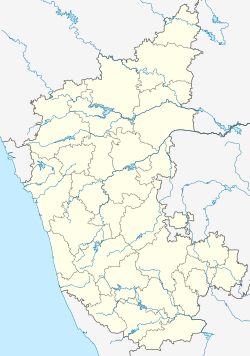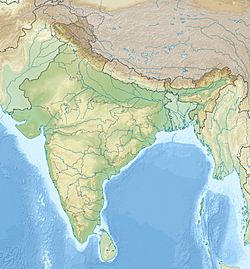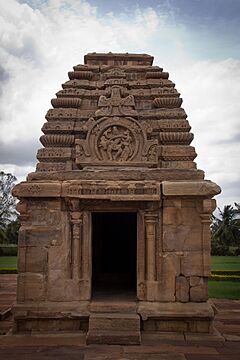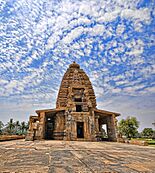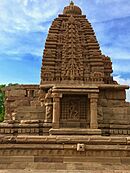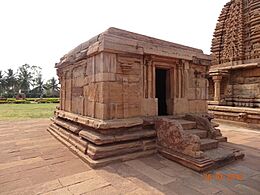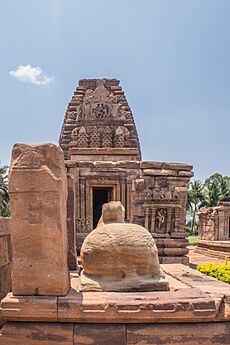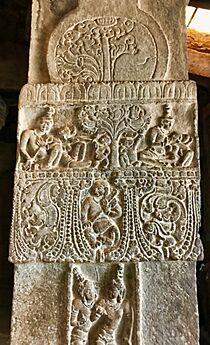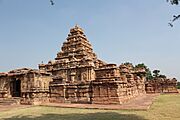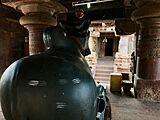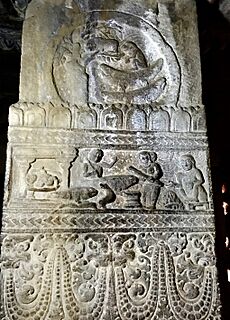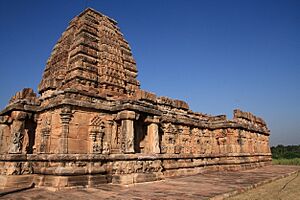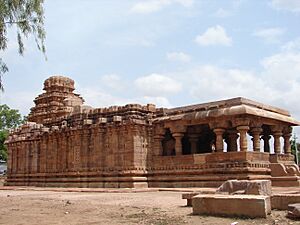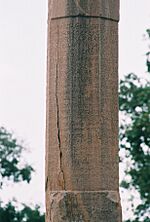Pattadakal facts for kids
|
Pattadakallu
|
|
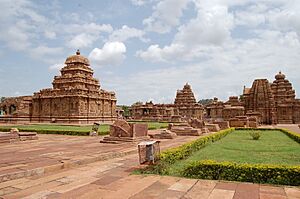
Temples of Pattadakal
|
|
| Location | Bagalkot district, Karnataka, India |
|---|---|
| Coordinates | 15°57′05″N 75°48′53″E / 15.95139°N 75.81472°E |
| Type: | Cultural |
| Criteria: | iii, iv |
| Designated: | 1987 (11th session) |
| Reference #: | 239 |
| Region: | Asia-Pacific |
Pattadakal, also known as Raktapura, is a group of ancient temples in northern Karnataka, India. These Hindu and Jain temples were built in the 7th and 8th centuries. It sits on the west bank of the Malaprabha River in Karnataka's Bagalkot district. This site is recognized by UNESCO as a World Heritage Site.
Pattadakal is about 23 kilometres (14 mi) from Badami and 9.7 kilometres (6 mi) from Aihole. Both Badami and Aihole are important places for Chalukya buildings. The Archaeological Survey of India (ASI) protects and manages Pattadakal under Indian law.
UNESCO says Pattadakal shows "a harmonious blend of architectural forms from northern and southern India." It is a great example of "eclectic art" at its best. Most Hindu temples here are dedicated to Shiva. However, they also feature ideas and stories from Vaishnavism (about Vishnu) and Shaktism (about the Goddess).
The carvings in the Hindu temples show many ancient Indian ideas. They tell stories from the Ramayana, the Mahabharata, and the Bhagavata Purana. You can also find parts of other Hindu texts like the Panchatantra. The Jain temple is dedicated to a single Jina, a spiritual teacher. The Papanatha and Virupaksha temples are the most detailed. They mix Northern and Southern styles beautifully. The Virupaksha temple is still used for Hindu worship today.
The Malaprabha River is a branch of the Krishna River. It flows through mountains and plains, playing a big role in South Indian history. This river starts in Kanakumbi, Belagavi district, in the Western Ghats. It flows east. Just one kilometre (0.62 mi) before Pattadakal, it turns to flow north. Hindus call a river flowing north an Uttarvahini Ganga, which is considered very holy.
Contents
Exploring Pattadakal's Location
The Pattadakal monuments are in the Indian state of Karnataka. They are about 165 kilometres (103 mi) southeast of Belgaum. From Goa, they are about 265 kilometres (165 mi) northeast. The site is 14 miles (23 km) from Badami and 6 miles (9.7 km) from Aihole. It is surrounded by sandstone mountains and the Malaprabha river valley.
The Pattadakal-Badami-Aihole area has over 150 Hindu, Jain, and Buddhist monuments. These date from the 4th to 10th centuries CE. There are also older dolmens (ancient stone tombs) and cave paintings.
You can reach Pattadakal by air or train:
- Airports:
- Train:
- Indian Railways has a service that stops at Badami. This station is on the Hubballi-Solapur line.
A Look into Pattadakal's Past
Pattadakal means "Stone of coronation." It was a sacred place because the Malaprabha river turned north here. This turn towards the Himalayas and Kailasha mountain was special. As its name suggests, the Chalukya dynasty used Pattadakal for coronation ceremonies. For example, Vinayaditya was crowned here in the 7th century CE.
Other names for this place were Kisuvolal, meaning "valley of red soil," and Raktapura, meaning "city of red." Pattada-Kisuvolal meant "red soil valley for coronation." The Archaeological Survey of India says that ancient texts mention this site. Ptolemy, a famous ancient writer, called it "Petirgal" in his book Geography.
The early Chalukya rulers in the 5th and 6th centuries worshipped Lord Vishnu (Vaishnavites). Later, they became followers of Lord Shiva (Shivaites). Because of this, many temples in and around Pattadakal are dedicated to Lord Shiva.
Pattadakal, along with nearby Aihole and Badami, became a major center for art and religion. It was a place where new ideas in architecture were tried out. The Gupta Empire brought peace in the 5th century. This allowed Aihole to become a place of learning. Over the next two centuries, these architectural experiments moved to Badami. By the 7th century, Pattadakal also became a hub. Here, ideas from northern and southern India came together. During this time, the Chalukya empire built many temples in the Aihole-Badami-Pattadakal area.
After the Chalukya Empire fell, the Rashtrakuta kingdom took over. They ruled the region until the 10th century. In the 11th and 12th centuries, the Late Chalukyas (also known as the Western Chalukya Empire) ruled. Even though Pattadakal was not a capital, new Hindu, Jain, and Buddhist temples continued to be built. This shows that many people lived there and the area was wealthy.
In the 14th century, armies from the Delhi Sultanate attacked and looted the Malaprabha valley and much of the Deccan region. This period of destruction ended when the Vijayanagara Empire rose to power. They built forts to protect the monuments, like the one in Badami. Pattadakal was on the border and saw wars between Vijayanagara and the Sultanates. After the Vijayanagara Empire fell in 1565, the Adil Shahi dynasty of Bijapur took control.
In the late 17th century, the Mughal Empire under Aurangzeb gained control. After the Mughal Empire collapsed, the Maratha Empire took over. Later, Haider Ali and Tipu Sultan controlled it in the late 18th century. But they lost it when the British defeated Tipu Sultan and took the region.
The monuments at Pattadakal show how early northern and southern Indian art styles mixed. In northern India, many ancient temples were destroyed by invaders from the 11th century onwards. So, the Pattadakal monuments from the 7th and 8th centuries are some of the oldest surviving examples of these early religious arts and ideas.
Ancient Stone Structures Recent findings by archaeologist Prof. Ravi Korisettar show that the Early Chalukyan builders were not the first to build in the Malaprabha Valley. At Bachinnagudda, near Pattadakal, there is an ancient stone monument called a dolmen. It dates back to the Iron Age (around 1200 BCE – 500 BCE). This type of structure, called a megalith, was built across southern India during the Iron Age.
What You'll See at Pattadakal
Temple Layout and Styles
Pattadakal has ten main temples: nine Hindu and one Jain. There are also many smaller shrines. Eight of the main temples are close together. One Hindu temple is about half a kilometer south, and the Jain temple is about a kilometer west. A walkway connects the Hindu temples, and the Jain temple has road access.
The temples at Pattadakal combine two main Indian architectural styles. One is from north India (Rekha-Nagara-Prasada), and the other is from south India (Dravida-Vimana). Four temples are in the Chalukya Dravida style. Four are in the Nagara style from Northern India. The Papanatha temple mixes both styles. All nine Hindu temples are dedicated to Shiva and are on the Malaprabha river banks.
The oldest temple is Sangameshwara, built between 697 and 733 CE. The largest is the Virupaksha Temple, built around 740 to 745 CE. The last temple built here is the Jain Narayana temple. It was likely built in the 9th century by the Rashtrakutas. Its style is similar to the Kailasanatha temple in Kanchipuram.
The temples were built using local sandstone. Some sculptures are carved from polished black granite.
Kadasiddheshwara Temple
This is a smaller temple. The Archaeological Survey of India (ASI) dates it to the mid-7th century CE. It faces east and has a square garbha griha (main shrine) with a linga (symbol of Shiva). A hall (mantapa) surrounds the shrine. Much of the temple has been damaged over time.
The spire (Shikhara) is in the northern Nagara style. It has a sukanasa (a projection) on the east. This sukanasa shows a damaged Nataraja (dancing Shiva) with Parvati. The outer walls of the shrine have images of Ardhanarishvara (half Shiva, half Parvati), Harihara (half Shiva, half Vishnu), and Lakulisha. Above the entrance, you can see Shiva and Parvati with Brahma and Vishnu. The steps are guarded by the river goddesses Ganga and Yamuna.
Jambulingeshwara Temple
The Jambulingeshwara temple is another small temple. It was likely finished between the mid-7th and early 8th centuries. It has a square garbha griha (shrine). Its outer walls have detailed niches with images of Vishnu, Surya (Sun god), and Lakulisha. This temple also has a sukanasa projecting from the spire over the hall. It faces east to greet the sunrise. The Nandi (Shiva's bull) statue in front is eroded. The dancing Shiva Nataraja with Parvati and Nandi on the front arch is better preserved.
The temple's style is northern rekha-nagara, with a curved shape that narrows as it rises. The top parts, the amalaka and kalasha, are missing. The entrance to the hall has three decorated frames. A frieze of swans covers the passageway.
Galaganatha Temple
The Galaganatha temple is east of the Jambulingeshwara temple. ASI dates it to the mid-8th century, while others suggest the late 7th century. It is a northern rekha-nagara style temple with a linga in its shrine. A seated Nandi faces the shrine outside.
The shrine has a covered path for walking around it (pradakshina patha). This shows that this Hindu tradition was common by the 7th-8th centuries. The temple also had a community hall (sabha mantapa) and an entrance hall (mukha mantapa), but only their foundations remain. The entrance is flanked by the river goddesses Ganga and Yamuna.
Most of the Galaganatha temple is in ruins. However, the southern part has a carving of an eight-armed Shiva killing the demon Andhaka. He wears a garland of skulls as a sacred thread. This temple is almost an exact copy of the Svarga Brahma temple in Alampur, Andhra Pradesh, built in 689 CE. This suggests that ideas were shared within the Chalukya kingdom. The base of the temple shows carvings of Panchatantra fables, like the mischievous monkey.
Chandrashekhara Temple
The Chandrashekhara temple is a small temple facing east, without a tower. It is south of the Galaganatha temple. It is dated to the late 9th or early 10th century by some, and mid-8th century by ASI.
The temple has a shrine with a Shiva linga and a closed hall. A Nandi sits on a platform facing the linga. It is built on a raised platform (adhishthana). The outer walls have simple pillars. There are niches on the walls of the shrine. The entrance lacks a lintel but has guardians (dvarapala) on each side. The door frames are carved.
Sangameshwara Temple
The Sangameshwara temple, also called Vijayeshvara temple, is a large temple in the Dravida style. It faces east and is south of the Chandrashekhara temple. Inscriptions show it was built between 720 CE and 733 CE. The king who sponsored it, Vijayaditya, died in 734 CE, so the temple was left unfinished. Work continued on and off in later centuries. Inscriptions mention Hindu queens who supported the temple's art and building.
Even though it's not the biggest, it's very impressive. The temple has a square layout with an east-facing shrine. A covered path (pradakshina patha) surrounds the shrine, lit by three carved windows. Inside the shrine is a Shiva Linga. In front of the shrine is a vestibule with smaller shrines on each side. These once held carvings of Ganesha and Durga, but they are now missing. Further east is a seated Nandi. Beyond the vestibule is a hall with sixteen large pillars.
The tower (vimana) above the temple and its outer walls are well preserved. The vimana has two levels, topped with a square roof (kuta-sikhara) and a pot-like ornament (kalasha). The temple walls have many niches (devakostha) with carvings of Vishnu and Shiva. Some carvings are unfinished. The temple sits on a raised base with carvings of elephants and mythical creatures. Above the eaves are detailed carvings of playful dwarfs (ganas) holding up the temple.
The carvings show themes from Shaivism, Vaishnavism, and Shaktism. Shaiva art includes dancing Nataraja, Ardhanarishvara, Shiva with Bhringi, and Shiva fighting the demon Andhaka. Vaishnava art includes Vishnu's avatars like Varaha lifting the earth goddess.
Digs in 1969 and 1971 found an older brick temple structure beneath the hall. This suggests Sangameshwara was built over an even older temple, possibly from the 3rd century CE.
Kashi Vishwanatha Temple
The Kashi Vishwanatha temple is another smaller temple at Pattadakal. It is dated to the late 7th, early 8th, or mid-8th century. Like other temples, its center is a square shrine (garbha griha) with a linga. East of the shrine is a platform for a Nandi, with a seated Nandi statue. The temple also has a drain for water used in rituals (pranala) and a foyer (antarala) leading to a hall. The river goddesses Ganga and Yamuna are visible at the hall's entrance.
The temple sits on a raised platform with five layers of carvings. These 8th-century carvings show horses, elephants, lions, peacocks, and flowery designs. The walls have pillars supporting arch-like designs. The entrance door has Shiva guardians (dvarapala) on each side.
Carvings of Ardhanariswara and Lakulisha are on the northern wall of the hall, but they are damaged. The cornice (kapota) has motifs and carvings of playful dwarfs carrying garlands. Brackets show flying couples.
The tower above, in the North Indian Rekha-Nagara style, has five rising levels of squares. The amalaka and kalasha are missing. The sukanasa on the spire shows a dancing Uma-Maheshwara (Parvati-Shiva).
Inside, the pillars are carved with stories from the Bhagavata Purana (Vaishnavism), the Shiva Purana (Shaivism), and the Ramayana. One carving shows the demon Ravana lifting Mount Kailasha. Others show Krishna's playful stories. One special carving shows Shiva coming out of a linga. The hall ceiling has carvings of Shiva, Nandi, and Parvati holding Kartikeya. This image is surrounded by the eight directional guardians.
Mallikarjuna Temple
The Mallikarjuna temple is a Shiva temple from the mid-8th century. Queen Trailokyamahadevi sponsored it. It is south of the Kashi Vishwanatha temple and close to Virupaksha. It was built around the same time as the Virupaksha temple, with a similar design but is smaller.
This temple shows a fully developed South Indian vimana style. Its shrine (garbha griya) has a Shiva linga and a path for walking around it (pradakshina patha). In front of the shrine is an antechamber with small, now empty, shrines for Durga and Ganesha. A Nandi faces the shrine in its own hall. You enter the shrine through a pillared community hall (sabha-mantapa) with porches.
The Mallikarjuna temple is similar to Virupaksha but has new architectural ideas. For example, the dancing Shiva (Nataraja) in this temple is in the arch of the sukanasa. Also, the top level of the tower (shikara) lacks certain decorative elements, and its roof is rounded, unlike Virupaksha's square roof.
Stone carvings tell stories throughout the temple. Legends from Hindu epics and the Puranas are on the pillars in the community hall. These stories cover Shaivism, Vaishnavism, and Shaktism. Krishna's rasa lila from the Bhagavata Purana and fables from the Panchatantra are shown. Like other Hindu temples, the Mallikarjuna temple has carvings of couples in romantic scenes. Other carvings show daily life, like a worker with an elephant carrying a log, and women with different expressions. One woman plays an 8th-century musical instrument.
Virupaksha Temple
The Virupaksha temple, next to the Mallikarjuna temple, is the largest and most detailed monument at Pattadakal. In old writings, it's called "Shri Lokeshvara Mahasila Prasada," named after its sponsor, Queen Lokmahadevi. It was built around 740 CE. It was built after King Vikramaditya II's successful wars against the Pallavas. An inscription mentions a grant to the "musicians of the temple" by the Queen. It also names the chief architect, "Gunda Anivaritacharya."
Like other temples at Pattadakal, the Virupaksha temple faces east. It has a square shrine (garbha griha) with a Shiva Linga. A covered path (pradakshina patha) surrounds it. In front of the shrine is an antechamber with two small shrines. These have images of Ganesha and Parvati as Durga, killing the buffalo demon. The Nandi pavilion outside is also aligned east-west. The temple area is a rectangle of connected squares, with carved walls. There were once 32 smaller shrines inside, but most are now gone. The entrance leads to a hall with 18 columns.
The tower above the shrine has three levels, shaped like a pyramid. Each level has designs similar to those below. The third level is simpler. A pot-like ornament (kalasha) crowns the temple. This pot is 17.5 metres (57 ft) above the pavement, making it the tallest pre-9th century South Indian temple. The sukanasa on the tower is very large, making it easy to see from far away.
The walls of the shrine and the nearby hall are covered with detailed carvings. These carvings show gods and goddesses from Shaivism, Vaishnavism, and Shaktism. Examples include Narasimha and Varaha (Vaishaivism), Bhairava and Nataraja (Shaivism), Harihara (half Shiva-half Vishnu), Lakulisa (Shaivism), Brahma, Durga, Saraswati, and Lakshmi. The carvings on the outside walls are some of the most numerous on any Early Chalukya building. Besides gods, many panels show people, couples, or individuals with jewelry or tools.
The temple has many carvings on various topics. For example, two men wrestling, a sage with Vishnu, a sage with Shiva, Vishnu saving the elephant Gajendra, and scenes of hermits meditating. Ancient gods like Surya riding his chariot and Indra on an elephant are also carved. Some carvings show scenes from the Ramayana, like Hanuman sitting on a high chair made of his tail, the golden deer, Sita being kidnapped, and the struggles of Rama and Lakshmana. Other carvings show scenes from the Mahabharata, Krishna's birth and playful life from the Bhagavata Purana, and fables from the Panchatantra.
The temple has important old writings (inscriptions). These tell us about society and culture in 8th-century India. For instance, one inscription mentions a grant to the "musicians of the temple" by the queen.
The famous Kailasha temple at Ellora Caves was inspired by this temple. The Virupaksha temple itself was inspired by the Kailasanatha temple at Kanchipuram.
Papanatha Temple
The Papanatha temple is separate from the main group of eight temples. It is about half a kilometer south of Virupaksha. It was built towards the end of the Early Chalukya rule, around the mid-8th century. This temple is known for its unique mix of Dravida and Nagara Hindu temple styles.
The temple's unusual design might be because it was built in three stages. However, there isn't clear evidence for this. Its architectural details show a consistent plan. The temple is longer, with two connected halls, one with 16 pillars and another with 4. The decorations and some parts of the layout are Dravida style. But the tower and carved niches are in the Nagara style.
Like the other temples, the Papanatha temple faces east. It has a Shiva linga in its shrine (garbha griya), but no separate Nandi-mandapa. Instead, a Nandi statue is in the main hall (sabha mantapa) facing the shrine. The temple walls have carvings of gods and themes from Shaivism and Vaishnavism. Durga is shown in one of the niches. Detailed panels on the walls show legends like the Ramayana and parts of the Kiratarjuniya.
The center of the ceiling has a detailed Shiva Nataraja. Other ceiling slabs show Vishnu, including one where he is reclining. Outside, in the halls, are images of women and couples in romantic scenes. Many panels show musicians with different instruments.
Jain Narayana Temple
The Jain temple at Pattadakal was built in the 9th century. It might have been sponsored by Rashtrakuta King Krishna II or the Kalyani Chalukyas. Unlike the other nine temples, this one does not have Hindu gods or detailed panels. Instead, it has a statue of a Jina (a Jain spiritual teacher) carved into the north side.
Like the Hindu temples, this temple has a square shrine, a path for walking around it, an antechamber, a hall (mantapa), and a porch. The hall is divided into seven sections on the north and south walls. These sections have narrow niches with seated Jinas. The sections are in the North Indian style, and the tower has a carved square spire (shikhara).
The hall has a row of smooth sandstone pillars. The railings are decorated with dancers, pots, and mythical creatures. Some of the artwork is unfinished. The entrance has carvings of a life-sized elephant torso with riders. The niches in this Jain temple hall might have once held images.
The Archaeological Survey of India has dug at the site. They found evidence of an older temple and Jain presence. They uncovered "the remains of a large temple complex built in bricks and also a beautiful sculpture of Tirthankara standing... indicating the existence of a temple, probably belonging to before or beginning of the early Chalukyan rule."
Other Discoveries and Writings
Many inscriptions in the old Kannada language have been found at Pattadakal. These are especially notable in the Virupaksha, Sangameshwara, and Papanatha temples. These inscriptions are important because they tell us about the grants made by King Vikramaditya, Vijayaditya, various queens, and others. These grants helped build and run the temples.
They also give us valuable information about how different Indian scripts developed. For example, one 8th-century pillar has inscriptions in two Sanskrit scripts: the northern Indian Siddhamatrika script and the southern Indian Kannada script.
Other important structures at Pattadakal include a single stone pillar with many inscriptions. There's also the Naganatha temple and the Mahakuteshwara temple, which also have many inscriptions. Several small shrines are dedicated to Shiva. Near the Virupaksha, Sangameshwara, and Mallikarjuna temples, there is a Shiva stone pillar. It has a trident symbol. The pillar's inscriptions say it was put up by Jnana Shivacharya from Mrigathanikahara, a place on the north bank of the Ganges. He also gave land to the Vijayeshwara temple.
In 2008, archaeologist S. Venkateshaiah found the quarry where the stones for the temples came from. It's about 5 kilometers from Pattadakal. This site has sketches of Shiva, Nandi, Durga, Ganesh, tridents, peacocks, and swastikas. These might be symbols of the groups (sanghata) that quarried and supplied the stones.
Why Pattadakal is Important
According to art historian Cathleen Cummings, the monuments at Pattadakal are a historically important example of religion, society, and culture in the Deccan region. They show the Hindu kingship and religious beliefs of 8th-century India. She says that the artists show the ideas of Dharma (duty, virtue) and Moksha (freedom) in Hindu beliefs, especially in Pashupata Shaivism. She also notes that the importance is not just in individual images. It's also in where they are placed and how they show the historical tension between a householder's life and a monk's life.
The ideas of Dharma, especially raja-dharma (royal duty), shown by Rama, and Moksha are seen throughout the temples. Dharma is shown in carvings of Rama's life from the Ramayana. Moksha is shown with images of Lakulisha, Nataraja, Yoga, and many holy people. Other common images at Pattadakal show the balance between Purusha (soul) and Prakriti (matter), or masculine and feminine.
The temples at Pattadakal show how the Chalukyas liked to combine and experiment. This led to a mix of Northern and Southern Indian architectural styles. This is clear when you look at the architecture in Pattadakal, Aihole, and Badami together. Aihole, in the 5th century, was where these ideas for mixing styles began. These ideas were then improved in Badami in the 6th and 7th centuries. UNESCO describes Pattadakal as the "peak of an eclectic art." It achieved a "harmonious blend of architectural forms from the north and south of India" in the 7th and 8th centuries.
Music and Arts in Ancient Times
Among the sculptures at Pattadakal, there is one from the 10th century showing a long-necked lute (like a Sitar). The site also has carvings of other musical instruments. The long-necked lute suggests that musicians were creating new instrument designs. Another example is the 7th-century stick zithers carved in the bas-relief at Mahabalipuram in Tamil Nadu.
See also
- Aihole
- Alampur group of temples, Telangana
- Badami cave temples
- Ellora Caves
- Gajendragad
- Lakkundi
- List of State Protected Monuments in Karnataka
- Mahadeva Temple (Itagi)
- Mahakuta group of temples
- Sirpur Group of Monuments
- Sudi


